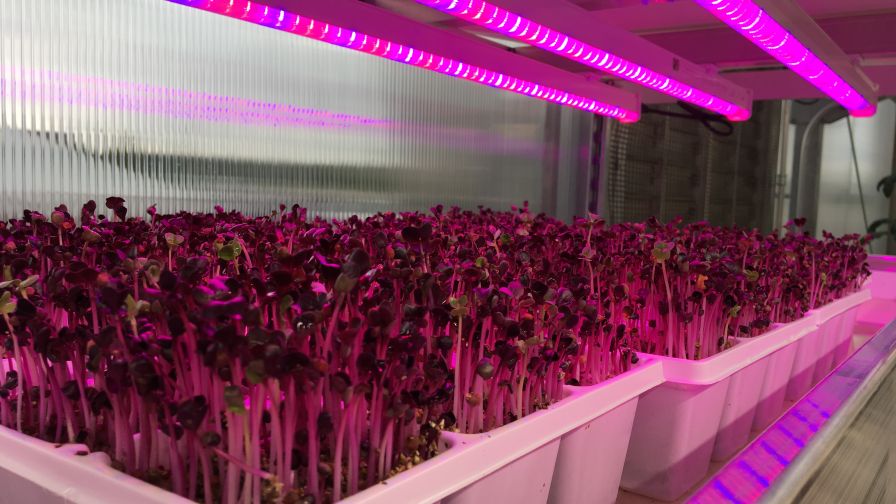A Roundup of the Latest Lighting Research for CEA Production

Photo: Resource Innovation Institute
In the ever-evolving landscape of greenhouse growing, the pursuit of optimal crop growth is an ongoing quest. Growers are turning to cutting-edge technologies to enhance yield, quality, and sustainability. Among these advancements, horticultural lighting has emerged as a beacon of innovation, fundamentally transforming the way controlled-environment agriculture (CEA) operators nurture and harvest crops.
The popularization of advanced LED lighting systems (especially in indoor farms) has opened up lighting customization possibilities, with features such as dimmable controls and spectral tuning promising to optimize crop steering and energy efficiency.
The application of LEDs is increasingly being studied by both academia and private operations looking to identify the optimal lighting settings for their crops, and researchers are publishing their results at a rapid clip.
Here, Resource Innovation Institute (RII) reviews some of the recently completed and ongoing research work in this field. From the mesmerizing world of LED spectra to the intricacies of light intensity management, discover the groundbreaking discoveries and practical insights driving this dynamic field forward.
Light Spectrum Research
Dr. Nathan Eylands, a recently hired assistant professor in the Department of Horticultural Science at the University of Minnesota, has researched the impacts of various lighting spectra on horticultural outcomes, an area of research in which he continues to have interest.
Some of his completed work on light quality investigated the role of far-red electromagnetic radiation on crop outcomes. What he has found is that when it comes to the light spectrum, plants can be placed in two categories: far-red tolerators, and far-red intolerant plants.
“Some of those tolerant ones, like lettuce, would get these broad leaves, whereas some of the more intolerant ones, maybe tomatoes or hemp/cannabis, might get a long internode,” Eylands shares.
For example, some of his past research looked at cellular growth in Rex lettuce under three different far-red light treatments: 1) a standard white LED with 2% far-red, 2) a 20% far-red, and 3) another treatment at 40%. The second treatment is ”about where the sun is going to put us at,” Eylands says.
“Looking at hosts of different cells … and trying to get a sense of where these cells are expanding, as well as whether it is just cell expansion or is it proliferation as well? Are they dividing? And what I found is that 20% [far-red] … is where we’re getting a really nice expansion rate without negatively impacting plant architecture. We’re getting good heads that aren’t starting to bolt, and it doesn’t turn bitter or decrease other marketable factors.”
While that amount of far-red produced good lettuce heads, “you are sacrificing chlorophyll content, anthocyanin, and different secondary metabolites that are good for human health” he adds.
Now, Eylands is now starting to turn his attention to dynamic spectra to identify potential light recipes that can change as the crop matures. In his far-red light studies on Rex lettuce, he identified that, although growth continued, the rate of cellular expansion flatlined at roughly day 26.
“This might be a good opportunity to insert a lot of blue light,” Eylands says. “If you’re growing in a deep water culture system, you have floating rafts and you put transplants on one side and they move as you harvest out the other side. If you’re growing whole heads, at day 26, that spectrum could be transitioned maybe to a blue light to try to increase anthocyanin content along with other secondary metabolites.”
By using two different fixed spectra lighting fixtures, the plants’ perception of the spectrum would change as it moves from one end of the growing space to the other. This setup would achieve a similar effect to adjustable-spectrum lights, which can still be too costly for some commercial grows to implement at scale.
Another area of research he’s keeping a close eye on is the application of light management films in greenhouse settings. This technology could be applied to convert high-energy photons (short wavelength: like blue) and re-emit a lower-energy photon (long wavelength: like red). While the technology is still in its research and development phase, it could improve the efficiency and efficacy of greenhouse cultivation. Eylands’ research will focus on the ability to mechanically interchange films depending on the ambient solar irradiance.
He also looks to already established pioneers in the lighting research space, such as Dr. Mark Lefsrud of McGill University, who Eylands says has been investigating what Lefsrud refers to as “amber” light. Amber sits at the 595 nm wavelength, which is theorized to be more efficacious than red light in terms of plant productivity.
However, it is important to note that most academic studies on lighting quality are done in growth chambers that resemble small-scale indoor farms. Eylands tips that the impact of light quality on crop outcomes may be different in commercial greenhouse settings. “A lot of these spectrum studies that we’re doing, they work really well in a growth chamber,” he says. “But when we try to replicate those results in the greenhouse, the sun’s spectrum is washing out that supplemental lighting and whatever spectrum you’re trying to provide.”
Light Intensity Research
While many researchers and LED companies are investing in light spectrum research, Dr. Kellie Walters, an Assistant Professor in the Department of Plant Sciences at the University of Tennessee-Knoxville, says much work remains to be done in the realm of lighting intensity.
“My view from a foundational research standpoint is we need to first optimize light intensity and then work on light quality,” she says. “A lot of the original light quality work has relatively low light intensities, and plant responses to light spectra can differ based on light intensity. You can potentially have different crop responses from a purple coloration standpoint, from a phytonutrient standpoint, or a volatile aroma/flavor standpoint.”
Similar to what Eylands noticed in translating growth chamber research into greenhouses, “if you increase that intensity, sometimes some of those [spectral] differences are washed out or you might have somewhat different responses,” Walters notes.
For example, increasing blue light can stimulate the production of anthocyanins in Rex lettuce varieties, but similar results can be achieved simply by increasing the lighting intensity, Walters says.
“If you increase the intensity, you could also increase photosynthesis,” Walters says. “My main goal from an initial research standpoint is to really lay that foundation from a light intensity perspective, because if you’re increasing the light intensity, that’s increasing the resource input for that area. But if you increase the resource input by 50% [and] you have a 100% increase in yield or a decrease in time to harvest, that increased resource input may actually be beneficial from an output perspective.”
Dimmable lighting fixtures have given CEA operators more control over the amount of light their crops receive. Similar to dynamic light spectra, leveraging these technologies by manipulating intensities at different growth stages may see some potentially economically interesting crop outcomes.
For example, a recent study Walters participated in looked at the impact on yield and carotenoid content of light intensity during green-leaf butterhead lettuce propagation. Walters and other researchers grew Rex lettuce seedlings under sole-source light intensities of 60, 100, 200, 400, or 600 µmol/m2/second then transplanted the seedlings into a common greenhouse environment. The group “observed a 475% fresh mass enhancement in seedlings grown under 400 versus 60 µmol/m2/second, with a 174% improvement persisting to final harvest.” Higher seedling light intensities also generally increased leaf numbers in seedlings and at final harvest, as well as seedling carotenoid concentrations.”
However, “final harvest carotenoid concentrations generally decreased with increasing light intensity,” meaning growers looking to optimize for secondary metabolite content should be mindful of light intensity during the propagation stage.
Dr. Walters’ lab is currently working under two grants focused on culinary herbs and leafy greens, examining the impact of both light intensity and quality on crop nutrition.
“In my lab, we do a lot of phytonutrient quantification–your different vitamins, different beneficial nutrients. From a culinary herb perspective, can we increase the flavor compounds?” she asks. “Can we alter crop quality in an efficient manner?”
In a study she conducted in 2022 examining how basil seedling production environment influences subsequent yield and flavor compound concentration during greenhouse production, when light intensity shifted from 100 to 600 µmol/m2/second “basil seedlings were 38% taller, had a 713% larger leaf area, and had 65% thicker stems; at harvest, plants were 24% taller, had 56% more branches, 28% more nodes, 22% thicker stems, and weighed 80% more when fresh and dry.”
The study also found that “eugenol concentration was greater in plants grown under a PPFD of 600 [µmol/m2/second] as seedlings compared to lower intensities,” with the researchers concluding that “increasing radiation intensity during seedling production under sole-source lighting can carry over to increase subsequent yield and eugenol concentration during finished production.”
Studying both light intensity and light quality will continue to yield incredibly important results for the CEA industry. But as with studying any living organism, it is important for both academics and R&D-inclined CEA facility operators to consider the interaction of the various environmental inputs that go into crop production, Walters says.
“All these environmental factors that are coming together, but also different cultural factors as well: nutrient solutions, … water quality … production systems. These end up making things very complicated,” to study and make valid conclusions, she says. “If you have all of that raw data, and the ability to process the data, and the know-how to complete the analyses, I think you could draw much better conclusions.”
Collaboration between academia and industry is pivotal as the CEA industry deepens its understanding of the impact of light intensity and light quality on crop outcomes, all the while keeping in mind resource use and sustainability goals. The advancements ahead promise a greener, more sustainable future.









